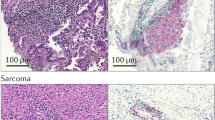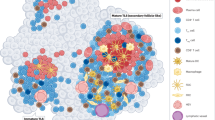Abstract
Tumor microenvironments (TME) are usually immunosuppressive and prevent lymphocyte priming. Recent clinical trials have shown that cancer immunotherapy such as immune checkpoint inhibitors can induce unprecedented durable responses in patients with a variety of cancers. Tertiary lymphoid structures (TLS) can form inside or adjacent to tumor tissues due to persistent inflammation. The formation of TLS facilitates lymphocyte trafficking and infiltration into tumor tissues. It can also support effective antigen presentation and lymphocyte activation. Thus, TLS have become an intriguing target to manipulate antitumor immunity. Several therapeutics targeting TLS have been developed and shown promising antitumor effects in various mouse models. In this chapter, we describe the general approach to establish transplantable mouse tumor models for the study of immunotherapy. We introduce the strategies for therapy through systemic or local treatment targeting TLS. We also present approaches to evaluate the antitumor immune responses provoked by the therapies.
Access this chapter
Tax calculation will be finalised at checkout
Purchases are for personal use only
Similar content being viewed by others
References
Holohan C, Van Schaeybroeck S, Longley DB, Johnston PG (2013) Cancer drug resistance: an evolving paradigm. Nat Rev Cancer 13(10):714–726
Couzin-Frankel J (2013) Cancer immunotherapy. Science 342(6165):1432–1433
Sunshine J, Taube JM (2015) Pd-1/Pd-L1 Inhibitors. Curr Opin Pharmacol 23:32–38
Chen DS, Mellman I (2013) Oncology meets immunology: the cancer-immunity cycle. Immunity 39(1):1–10
Woo S-R, Corrales L, Gajewski TF (2015) Innate immune recognition of cancer. Annu Rev Immunol 33:445–474
Tang H, Zhu M, Qiao J, Fu Y-X (2017) Lymphotoxin signalling in tertiary lymphoid structures and immunotherapy. Cell Mol Immunol 14:809–818
Yu P, Lee Y, Liu W et al (2004) Priming of naive T cells inside tumors leads to eradication of established tumors. Nat Immunol 5(2):141–149
Sautès-Fridman C, Fridman WH (2016) TLS in tumors: what lies within. Trends Immunol 37(1):1–2
Lukashev M, LePage D, Wilson C et al (2006) Targeting the lymphotoxin-β receptor with agonist antibodies as a potential cancer therapy. Cancer Res 66(19):9617–9624
Schrama D, thor Straten P, Fischer WH et al (2001) Targeting of lymphotoxin-α to the tumor elicits an efficient immune response associated with induction of peripheral lymphoid-like tissue. Immunity 14(2):111–121
Johansson-Percival A, Li Z-J, Lakhiani DD et al (2015) Intratumoral LIGHT restores pericyte contractile properties and vessel integrity. Cell Rep 13(12):2687–2698
Tang H, Wang Y, Chlewicki LK et al (2016) Facilitating T cell infiltration in tumor microenvironment overcomes resistance to PD-L1 blockade. Cancer Cell 29(3):285–296
Johansson-Percival A, He B, Li Z-J et al (2017) De novo induction of intratumoral lymphoid structures and vessel normalization enhances immunotherapy in resistant tumors. Nat Immunol 18:1207
Dieu-Nosjean MC, Giraldo NA, Kaplon H et al (2016) Tertiary lymphoid structures, drivers of the anti-tumor responses in human cancers. Immunol Rev 271(1):260–275
Dieu-Nosjean M-C, Goc J, Giraldo NA et al (2014) Tertiary lymphoid structures in cancer and beyond. Trends Immunol 35(11):571–580. https://doi.org/10.1016/j.it.2014.09.006
Weinstein AM, Storkus WJ (2015) Therapeutic lymphoid organogenesis in the tumor microenvironment. In: Xiang-Yang W, Paul BF (eds) Advances in cancer research, vol 128. Academic Press, pp 197–233. https://doi.org/10.1016/bs.acr.2015.04.003
Coppola D, Nebozhyn M, Khalil F et al (2011) Unique ectopic lymph node-like structures present in human primary colorectal carcinoma are identified by immune gene Array profiling. Am J Pathol 179(1):37–45. https://doi.org/10.1016/j.ajpath.2011.03.007
Di Caro G, Bergomas F, Grizzi F et al (2014) Occurrence of tertiary lymphoid tissue is associated with T-cell infiltration and predicts better prognosis in early-stage colorectal cancers. Clin Cancer Res 20(8):2147–2158
McMullen T, Lai R, Dabbagh L et al (2010) Survival in rectal cancer is predicted by T cell infiltration of tumour-associated lymphoid nodules. Clin Exp Immunol 161(1):81–88
Messina JL, Fenstermacher DA, Eschrich S et al (2012) 12-Chemokine gene signature identifies lymph node-like structures in melanoma: potential for patient selection for immunotherapy? Sci Rep 2:765
Pitzalis C, Jones GW, Bombardieri M, Jones SA (2014) Ectopic lymphoid-like structures in infection, cancer and autoimmunity. Nat Rev Immunol 14(7):447
Wick M, Dubey P, Koeppen H et al (1997) Antigenic cancer cells grow progressively in immune hosts without evidence for T cell exhaustion or systemic anergy. J Exp Med 186(2):229–238
Lee Y, Chin RK, Christiansen P et al (2006) Recruitment and activation of naive T cells in the islets by lymphotoxin β receptor-dependent tertiary lymphoid structure. Immunity 25(3):499–509
Yang D, Ud Din N, Browning DD et al (2007) Targeting lymphotoxin β receptor with tumor-specific T lymphocytes for tumor regression. Clin Cancer Res 13(17):5202–5210
Sharma S, Stolina M, Luo J et al (2000) Secondary lymphoid tissue chemokine mediates T cell-dependent antitumor responses in vivo. J Immunol 164(9):4558–4563
Hillinger S, Yang S, Batra R et al (2006) CCL19 reduces tumour burden in a model of advanced lung cancer. Br J Cancer 94(7):1029–1034
Reisfeld RA, Gillies SD, Mendelsohn J et al (1996) Involvement of B lymphocytes in the growth inhibition of human pulmonary melanoma metastases in athymic nu/nu mice by an antibody-lymphotoxin fusion protein. Cancer Res 56(8):1707–1712
Moussion C, Girard J-P (2011) Dendritic cells control lymphocyte entry to lymph nodes through high endothelial venules. Nature 479(7374):542–546
Chai Q, Onder L, Scandella E et al (2013) Maturation of lymph node fibroblastic reticular cells from myofibroblastic precursors is critical for antiviral immunity. Immunity 38(5):1013–1024
Funding
Y.X.F. holds the Mary Nell and Ralph B. Rogers Professorship in Immunology. This work was in part supported by the US National Institutes of Health through National Cancer Institute grants CA141975 and CA97296, CPRIT grant RR150072, grants from the Chinese Academy of Sciences (XDA09030303), and the Chinese Ministry of Science and Technology (2012ZX10002006, 2011DFA31250, and 2012AA020701) to Y.X.F.
Author information
Authors and Affiliations
Corresponding author
Editor information
Editors and Affiliations
Rights and permissions
Copyright information
© 2018 Springer Science+Business Media, LLC, part of Springer Nature
About this protocol
Cite this protocol
Tang, H., Qiu, X., Timmerman, C., Fu, YX. (2018). Targeting Tertiary Lymphoid Structures for Tumor Immunotherapy. In: Dieu-Nosjean, MC. (eds) Tertiary Lymphoid Structures. Methods in Molecular Biology, vol 1845. Humana Press, New York, NY. https://doi.org/10.1007/978-1-4939-8709-2_16
Download citation
DOI: https://doi.org/10.1007/978-1-4939-8709-2_16
Published:
Publisher Name: Humana Press, New York, NY
Print ISBN: 978-1-4939-8708-5
Online ISBN: 978-1-4939-8709-2
eBook Packages: Springer Protocols




